 |
 |
 |
| |
PF-232798, a Second Generation Pfizer Oral CCR5 Antagonist
|
| |
| |
Reported by Jules Levin
15th CROI, Feb 3-6, 2008, Boston
Patrick Dorr*, Mike Westby, Lynn McFadyen, Julie Mori, John Davis, Francesca Perruccio, Rhys Jones, Paul Stupple, Don Middleton, Manos Perros
Pfizer Global R&D - Sandwich Laboratories
Introduction
Maraviroc (MVC) is the first-in-class anti-HIV-1 CCR5 antagonist, with demonstrated clinical efficacy and convenient BID dosing.
Resistance to MVC in vitro and in the clinic can occur via envelope mutations that enable HIV entry through recognition of MVC-bound receptor. We have previously shown that MVC-resistant virus generated in vitro can be inhibited by antagonists from structurally related chemical series. We set out to identify an inhibitor with the pharmacokinetic and safety credentials of a second-generation clinical candidate and activity against MVC-resistant HIV.
Author Conclusions
· PF-232798 is a potent oral CCR5 antagonist with a primary and selectivity/safety pharmacology profile similar to MVC
· PF-232798 has potent broad-spectrum anti-HIV-1 activity, with similar potency to MVC
· PF-232798 is active against lab-generated MVC-resistant CCR5-tropic HIV-1. Further studies against clinically-derived CCR5-tropic MVC-resistant HIV isolates are warranted
· PF-232798 binds to the same pocket as MVC within the trans-membrane region of CCR5, but shows additional interactions at the ECL2 hinge region
· PF-232798 is well tolerated in normal volunteers
· PF-232798 has an unbound Cmin ~15-30 fold the antiviral EC90, and a superior systemic exposure profile (Cmin) in humans following a steady state 250mg QD vs. 300mg BID regime for MVC, highlighting potential for a QD therapeutic regimen
· Further studies to evaluate the clinical utility of PF-232798 for the treatment of HIV infection are warranted and ongoing
Methods
Pharmacology: PF-232798-dependent inhibition of the described CCR5 mediated and safety-associated pharmacological activities were assessed as previously described [1, 2].
Virology: Laboratory-generation of MVC-resistant HIV-1 isolates CC185 and RU570 and susceptibility profiling against PF-232798 in PBL culture were undertaken as previously described [3, 4].
CCR5 Antagonist Docking: Receptor modeling and antagonist docking was performed as previously described [2].
Phase I Clinical Pharmacokinetics and Safety: Studies were performed in healthy volunteers. Details of experimental parameters are included in the results section.
Results
PF-232798 is an imidazopiperidine CCR5 antagonist that was identified following a medicinal chemistry synthetic campaign guided by a bespoke biological screening cascade, following the identification of the triazole CCR5 antagonist, MVC (figure 1).
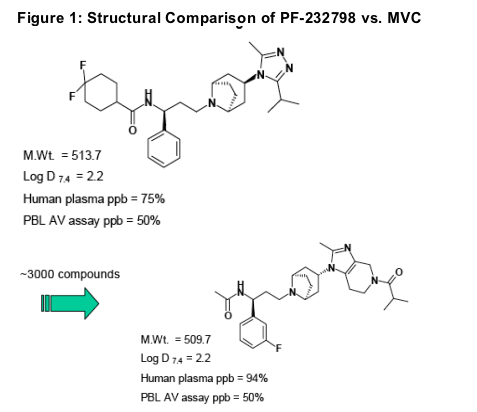
PF-232798 demonstrated very similar potencies to MVC in a range of CCR5 associated pharmacology assays, and potent antiviral activity vs. HIV BaL in PBL culture (EC90 2.0nM 95% CI 1.5 to 2.6nM) - see figure 2. Figure 3 shows a highly significant correlation (R2 = 0.93) between PF-232798 and MVC antiviral EC90 values as observed in the PhenoSense assay using env-recombinant clones from a cross clade panel representative of the reported primary isolates previously used to determine MVC potency in PBL culture (EC90 2nM), see ref. [1]. PF-232798 was highly selective for CCR5, as assessed by a range of in vitro and in vivo safety pre-clinical assays previously used to characterise MVC [1] - data not shown. These included EC50 values >10_M against HERG in patch clamp assay, inhibition of dofetilide binding to IKr, and <50% effect on the APD90 against isolated dog purkinje fibres (10_M dose).

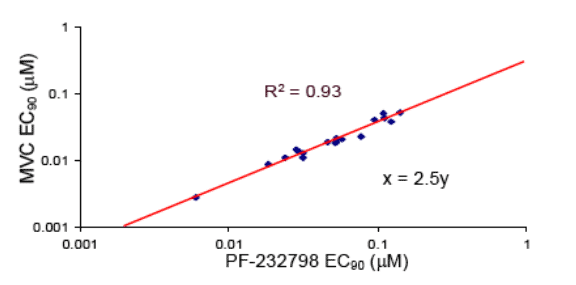
Data points represent geometric mean antiviral EC90 values across n = 18 envrecombinant (primary isolate CCR5 tropic source virus across clades A, B, C, D, E, F, G, H, and J). In a parallel study, no antiviral activity was observed against 3 dual tropic and 2 CXCR4-tropic env-recombinant clones.
PF-232798 retained full activity against an expanded clone of the B-clade MVC resistant isolate CC185 in PBL culture (figure 4). Partial retention (>50%) of activity was observed against an expanded clone of the G-clade MVC-resistant isolate RU570, although a lowered plateau effect was observed (figure 4). This was deemed significant in light of full retention being observed with saquinavir and alternative CCR5 antagonist templates aplaviroc and vicriviroc (data not shown).
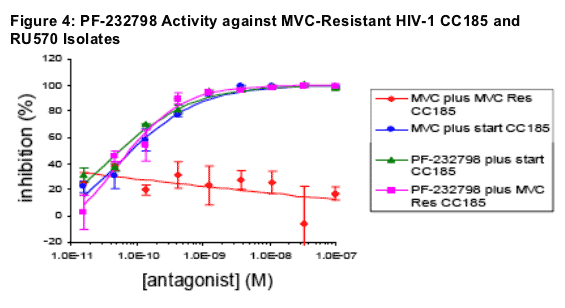

All assays performed in parallel PBL cultures. Data points represent mean values +/-S.E.M.
Site directed mutagensis studies undertaken to enable computer-assisted antagonist docking into CCR5, highlighted differential occupation of the PF-232798 imidazopiperidine and MVC tropane moieties at the ECL2 hinge region of the binding pocket (figure 5).
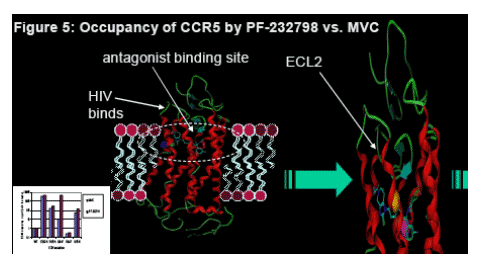
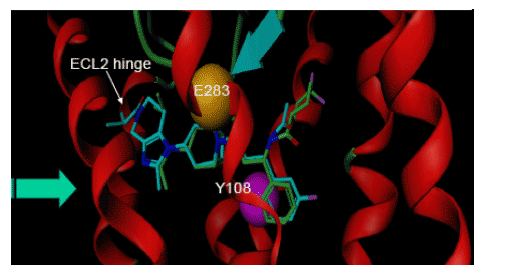
Diagrammatic representation of CCR5 in the cytoplasmic membrane of an immune cell. Overlaps of PF-232798 (pale blue) and MVC (green) are highlighted. Interaction of the ionic interaction between the basic nitrogen of the antagonists and hydrophobic interaction of their phenyl moieties with the E283 and Y108 residues respectively, in the trans-membrane pocket are highlighted. All images generated using the computer modeling Pfizer software package FLOPS (Flexes Ligands Optimising Property Similarity) and Pfizer crystal structure database, as guided by assay data from site directed alanine mutagenesis, where loss of functional binding was observed for E238A and Y108A mutants for MVC and PF-232798 [2] - see embedded bar-chart.
PF-232798 showed favourable properties in preclinical PK and toxicology studies (data not shown). In phase I studies, 24h trough PF-232798 unbound plasma concentrations at steady state following QD dosing (250mg) were significantly greater than those observed for MVC at 12h and 24h (300mg BID, steady state) - see figure 6. The frequency and pattern of adverse events were non remarkable up to a dose of 500mg (figure 7). There was a slightly increase frequency of adverse events at doses of 500mg and above including diarrhoea, dizziness, headache, and orthostatic hypotension. However, these adverse events were comparable to the placebo arm.
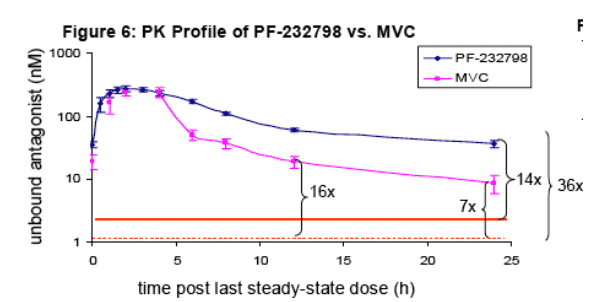
Data represents the mean unbound antagonist concentration in plasma +/- S.E.M. PF-232798 dosed at 250mg QD, 7 days dosing (n = 6 volunteers); MVC dosed at 300mg BID, 10 days (n = 8 volunteers). Total plasma levels were measured by HPLC-MS and corrected for in vitro plasma protein binding (75% and 94% for MVC and PF-232798 respectively). The red dotted line represents both the unbound antiviral geometric EC90 for MVC against 43 primary isolates [1], and the EC90 for PF-232798 against HIV BaL in PBL culture. The solid red line represents the estimated EC90 potency for PF-232798 against primary isolate HIV in PBL based upon the 2.5 fold lower activity vs. MVC observed against a panel of primary isolates in the PhenoSense assay (see figure 3).
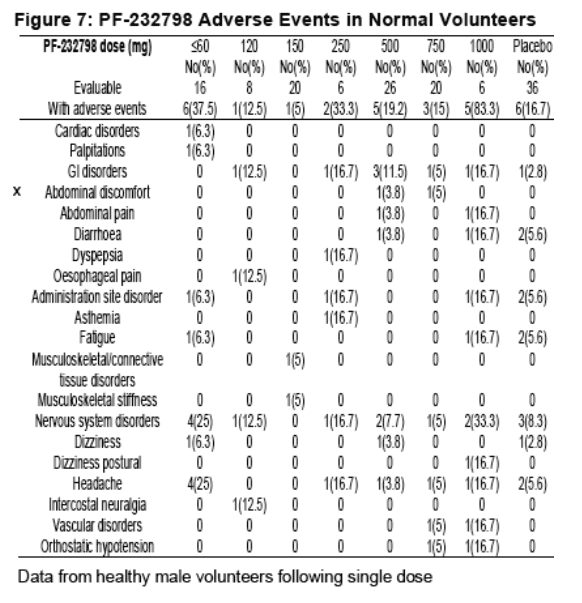
References
1. Dorr et al (2005). Antimicrob. Agent. Chemother. 49 (11): 4721 - 4732
2. Dorr et al (2005). 45th ICAAC. Abst H-411
3. Westby et al (2005). XIV Int HIV Drug Res Workshop
4. Westby et al (2006). J Virol. 2007 81(5): 2359-7
|
| |
|
 |
 |
|
|